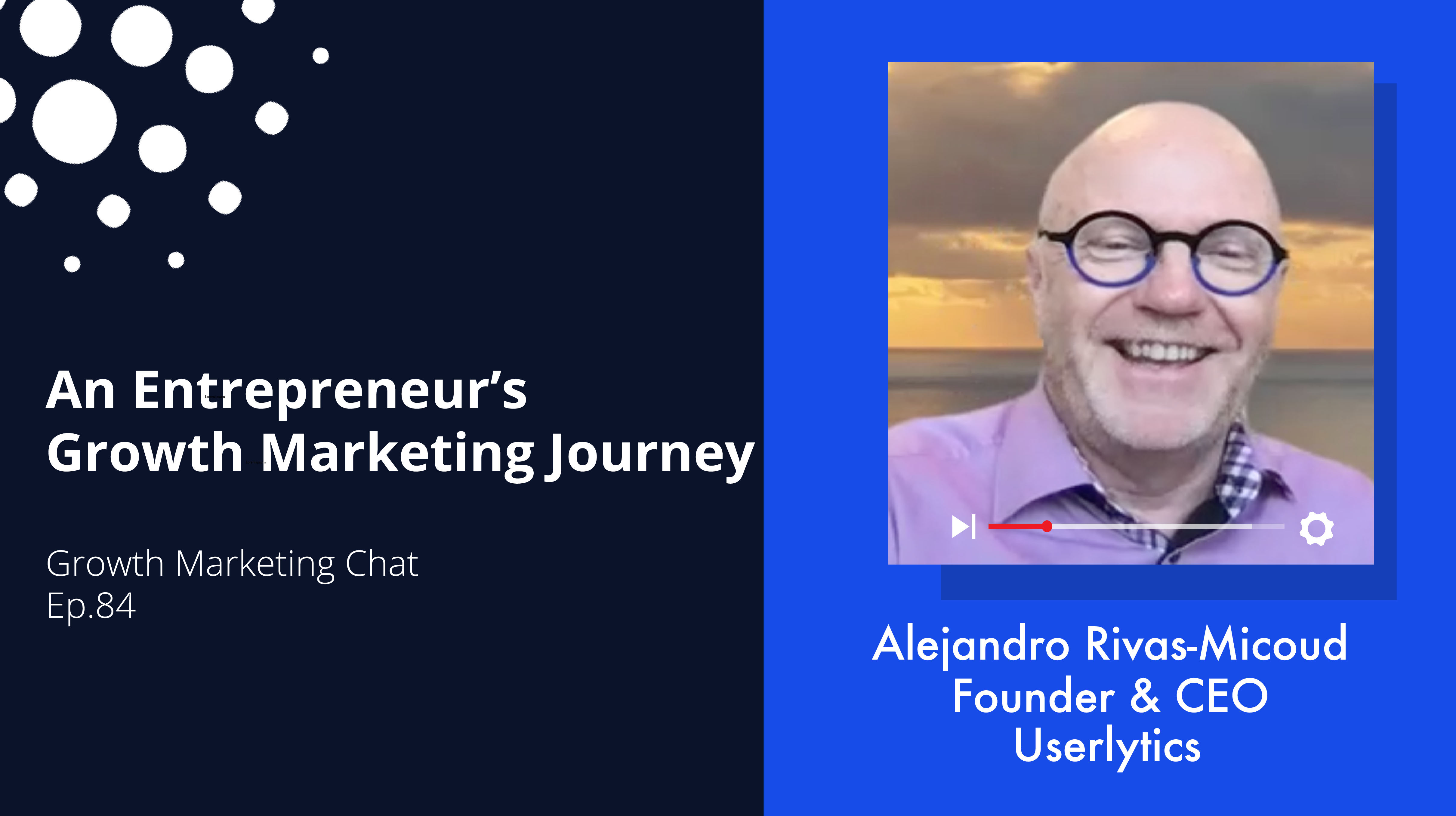Do you have a product or service that just doesn’t seem to require the most common marketing strategy and tactics?
We’re here to tell you that’s okay!
Bring Innovation to Life with Your Growth Marketing Strategy
The beauty of marketing is that you get to use it in the way that is best suited for your company. You have the freedom to be innovative and creative with your content marketing.
To inspire you, we brought Peter Voss, Founder, CEO & Chief Scientist of Aigo.ai, to join us on this week’s Growth Marketing Chat. He shares his unique experience and perspective on executing non-traditional marketing strategies.
Watch the interview to learn:
-
How and why to invest time in developing your innovative product
-
How to find a marketing approach that fits your needs
-
When it might be time to invest in more traditional marketing channels to scale your business
Video Transcript:
CAROLINE: Hi, welcome to Growth Marketing Chat. Today, I am here with Peter Voss, who is the founder and CEO, and chief scientist at Aigo.ai. Peter, thank you so much for being with me today.
PETER: Yes, thank you for having me.
CAROLINE: So I'm really excited about our interview. One of the great things about you, Peter, is that you've been starting a lot of different companies, you encountered a lot of success, and your companies are all very innovative, so I'm really, really excited to have you here, and I guess before we start, I'd really love for you to present Aigo, and tell us more about what you do.
PETER: Yes, certainly. To give a little bit of context and background, one of my companies was a software company, ERP Software, and it was very successful, but when I exited the company, I really thought, what improvement do I want to make to software? And what struck me is that software really is quite dumb. It doesn't have any intelligence. If the programmer didn't think of something, it will just come up with an error message, or it'll crash, or whatever, but it doesn't really have common sense, and it doesn't learn and improve, so how can we solve that problem?
So I embarked on a long-term research project to figure out what intelligence is, and how we can bring intelligence to software. And this, over many years, culminated in developing a product to automate phone calls. The thing that people usually hate, you call in to a company, and a robot tries to talk to you, and it's not very successful, and you just wanna press 0 to get to an operator. So with our technology, we have basically a brain, a cognitive engine, a thinking engine, that really understands and manages the conversation.
So that was the first company, the company's called Smart Action, utilizing this intelligent technology in call center automation. I exited the company about seven years ago to concentrate on taking this technology to the next level. And so we spent several years, again, in development, and just over a year ago, we now commercialized the second generation of our technology called Aigo.ai, or called Aigo, and what we are concentrating on now is automating chat, to have a chatbot with a brain. So because chat is becoming more and more popular, people actually don't particularly wanna talk to somebody, so they use chat, many advantages to that, so that's what we decided to concentrate on, and we basically commercialized this product.
So whereas the current chatbots, almost all of the chatbots that you come across, don't have any intelligence, they don't understand, deeply understand,what you're saying, they don't have memory, they don't remember what you said two sentences ago, never mind what you said a week ago, and they really can't reason, so by us having this brain that manages the conversation, you can do a lot more, and it's a much better experience for the individual user.
CAROLINE: Yeah, yeah, that's pretty great, because usually chatbots are really kind of a decision tree, right? Like, they are stupid, and it's pretty frustrating for the user, so that's very exciting technology, and that's also very new and innovative. So you took a little bit of a different approach than a lot of companies. You spent a lot of time developing the product, right, before actually going to market?
PETER: Yes, absolutely. So really, the technology that we've developed is very different from what other companies are using in chatbots. As you say, chatbots are really just a flow chart, a decision tree, where, please give me your phone number, or answer a question, if it's yes, you do this, and if it's no, you do something else. So that's extremely limited.
So developing this cognitive engine or brain that manages the chat conversation was actually a very large undertaking that took a lot of effort, a lot of money, time, and money, to develop that, and so we decided when we launched the company commercially because we have such a sophisticated product and the experience we already had from a previous business, that we would target large companies, so that our go-to-market strategy is to initially have a small number of large customers that we can get deeply involved with to ensure the success, to integrate it into their backend system, into their businesses, so that the conversation you're having can really be hyper-personalized to the individual user.
So when somebody… For example, one of our customers is a gifting retailer, and so we already know, in most cases, we already know a lot about the customer, what their preferences are, what kind of gifts they've bought before, who they bought them for, when they bought them, what the occasion was, so the conversation can be much more personalized and intelligent that we have. But to do that you need to... Obviously, the system needs to have all the business rules, it needs to be integrated with a backend system, so there's a fair amount of effort involved to really get the system to work an optimal way. So we decided to take that path so that we could really highlight what our technology is capable of. And we were very pleased in working with these handful of large companies and deeply integrating it, to offer hyper-personalization. But it takes a lot more effort, but then, so did our development.
CAROLINE: Right, so right. And so to find these companies, you didn't really invest in marketing, besides having a website and the foundations there. Can you tell us more about why you chose this approach, and what it brought you?
PETER: Yes, certainly. So again, it's a very unusual path that we took, that we decided we are targeting a small number of large companies. So the sales process is also very, very high level. I have a terrific partner in the business who does most of the sales, the limited marketing that we do, and then I also get very much involved in the sale. So it's really a very high-level sale.
So it's rather the small number and the quality of the sale rather than a numbers game, that we chose. And we did that, A, because we could, with the experience and the technology edge that we have, but also, it feeds into our long-term strategy that we really want to establish ourselves as the premier supplier of hyper-personalized, highly intelligent chatbots. And so for us to build a repertoire, essentially, of high-end customers, is really the strategy that we took, and it's a very personalized sale.
So the selling is done, or the way we reach our customers, is mainly through personal connections, through recommendations, through some conferences that we go to, very targeted conferences, and actually also through podcasts like this one, so that people can find out about our technology, and we have people contacting us to find out more. So that's actually a strategy that has worked well for us for the current phase that we're in. It is unusual to straight away go for large customers.
CAROLINE: It is. Okay, great. So that was really insightful. I guess my last question for you is that, once you start having this early growth in your early customers, at one point you're gonna want to scale, and the question I have for you is, when do you know, okay, now is the time that I start investing in traditional marketing and sales, and what kind of returns do you expect from that?
PETER: Yes, we actually have started engaging a CMO to help us develop a more comprehensive marketing plan, so we have already been very much gearing up for explosive growth in the near future in terms of getting our own internal infrastructure in place to be ready for the growth, in many things, in the staffing that we have, the training that we have, the internal systems for deployment, the tools that we've developed and are developing, all of that, to be ready for explosive growth. And really, we want to be at a place where we have about a dozen large customers as reference sites, that are fully up and running, and can be there, because that'll obviously make sales and marketing much more effective, being able to have good success stories, that people can clearly see what our technology is capable of, and what our company is capable of. So we see ourselves stepping up marketing, and going into more traditional marketing, where we go to a much wider audience to tell our story, later this year, and we're gearing up for that, but we're already making a significant investment to get ready for this ongoing growth.
CAROLINE: Right, all right. So I love that you brought up this point of having the right infrastructure behind you, not only having the case studies and the success stories, but also having the infrastructure to onboard your new clients, and sell to them. And that's really important. If you don't have this, you're wasting money in marketing.
PETER: Well, correct. And also, the thing is that's really important for us, we pride ourselves in the quality. We're really a quality-driven company. Our first objective is not just to have revenue and numbers, it's not the financial thing. Really, what we are focused on is offering a high-quality product and service. So we want to make sure that by the time we really expand very rapidly, and by the time we do marketing, that the company is fully ready, as well, to successfully engage a much larger range of clients, and one of the strategies that we're employing for that is that a lot of the sales and servicing of our product will be done through partners that we're busy working with, a number of companies, that have expertise to implement our technology, and already have an existing relationship with many companies, and then also to work with what we would call OEMs, companies that will embed our technology into their product. So those are additional ways in which we can scale. But nonetheless, then we would also want to gear up our marketing to help our partners to be more successful.
CAROLINE: Right, absolutely, absolutely. All right, Peter, thank you so much for participating. I really appreciate it.
PETER: Well, thank you for having me, and anybody, for more information, go to Aigo.ai. You can email me as well, peter@aigo.ai, and I'd be happy to provide more information. So thank you.





